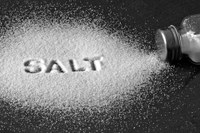Prairie Fare: How to shake the salt habit
(Click an image below to view a high-resolution image that can be downloaded)
The chef grabbed a small handful of salt and tossed it on the steaks he was grilling.
I could see the granules clearly with the background of smoke and steam rising from the grill.
I am sensitive to salt. If I eat too much salty food, I wake up parched with thirst. I need get up and drink a few cups of water.
As I watched the salt flying at the food, I could almost feel my body bloating and my blood pressure rising.
In fact, when I made my menu selection that evening, I chose something a little less salty.
What’s the issue with consuming extra salt, anyway? Too much salt, or sodium chloride, can have lasting health consequences. Excessive salt can narrow our blood vessels and increase our blood pressure.
High blood pressure can affect the blood vessels of our kidneys. The kidneys have to work harder to remove wastes and fluid from our body. Uncontrolled high blood pressure could lead to kidney failure without some intervention.
Unfortunately, 90% of children and adults consume too much sodium according to the Centers for Disease Control and Prevention.
That’s a grim statistic.
The good news is that we can make some positive changes in our lifestyle that can affect our health.
We might think the salt we add at the table is the culprit. However, highly processed foods are the largest contributor of sodium in our diet.
An estimated 70% of the sodium in our diet is from foods such as canned soups, frozen dinners and snack foods. According to the CDC, deli meat sandwiches, pizza, tacos, soups, chips, crackers, poultry, packaged dinner mixes (such as pasta), burgers, eggs and omelets account for 40% of the sodium we consume.
How can you shake the sodium habit?
Be a food product label reader. In 2021, all the Nutrition Facts labels on food products were required to be updated.
The daily value for sodium is less than 2,300 milligrams (mg) per day. The American Heart Association sets a lower limit of 1,500 mg per day.
The Nutrition Facts label lists the “percent daily value.” A food product such as a soup might have 50% of the daily value for sodium. In other words, that serving of soup is providing you with half of the upper limit for sodium.
Check out the serving size on the package. In our example, if you consumed two servings of the soup, you would be at 100% of the sodium recommendation for the day.
If a food product has 5% of the DV or lower, it is considered “low” in sodium. A product with 20% or more of the DV is considered “high” in that nutrient.
Many products that are “low sodium” will list that designation on the label. By law, low-sodium foods can have no more than 140 milligrams sodium per serving.
Choose more fresh or frozen fruits and vegetables without added sauces. Fruits and vegetables naturally have very low, if any, sodium. Fruits and vegetables are good sources of potassium, a mineral that helps maintain a healthy blood pressure.
When you purchase canned vegetables, opt for the reduced or no-sodium versions. You can reduce the sodium in canned beans by about 40% by draining them and rinsing them with water.
If you like salty foods, such as pickles, brined, cured foods and condiments, have smaller servings. Have one pickle instead of two and less ketchup and mustard. Through time, your “salty tooth” will decline.
How about using “sea salt”? Weight for weight, sea salt is similar in sodium level to table salt. If the larger granules cause you to use a little less, then you could reduce your sodium intake a bit. Be moderate in any type of salt you use.
Consider other ways to season your food. Fresh and dried herbs add flavor to your recipes without salt. Black pepper is sodium-free.
If you want to grow some fruits, vegetables and herbs, check out www.ag.ndsu.edu/fieldtofork for information about preparing and preserving foods.
This recipe is sodium-free and an excellent side to grilled chicken or salmon.
Citrus Salsa
1 mango, peeled and diced
1 large grapefruit, peeled, segmented and diced
½ red onion, diced
½ jalapeno, minced
¼ cup cilantro, finely chopped
Juice of 1 lime (approximately 2 tablespoons)
Salt and pepper to taste
Rinse fresh produce under water, then prepare the ingredients as directed.
Makes four servings. Each serving has 60 calories, 0 grams (g) fat, 1 g protein, 16 g carbohydrate, 2 g fiber and 0 milligrams sodium.
(Julie Garden-Robinson, Ph.D., R.D., L.R.D., is a North Dakota State University Extension food and nutrition specialist and professor in the Department of Health, Nutrition and Exercise Sciences. Follow her on Twitter @jgardenrobinson)
NDSU Agriculture Communication – May 25, 2023
Source: Julie Garden-Robinson, 701-231-7187, julie.garden-robinson@ndsu.edu
Editor: Elizabeth Cronin, 701-231-7881, elizabeth.cronin@ndsu.edu




